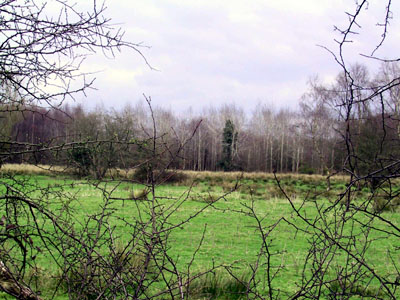
NEWTOWNDONORE: 9 April 2001: by Brian Byrne. In the kind of ‘desktop survey’ beloved of consultants there might be some logic in locating a public dump in Newtowndonore (above) near Robertstown.
It is central to the main waste-generating towns in both north and mid-county. It is physically and politically isolated, and there aren’t, relatively, too many people who might be discommoded.
There’s even a disused old Bord na Mona railway bed (below) which would give one handy access to the site.
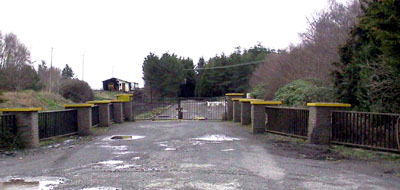
So Newtowndonore is one of three places on Kildare County Council’s shortlist for the next council waste disposal facility.
It is also a Special Area of Conservation in the same authority’s County Development Plan - the ‘bible’ of planning in the county for the next four years or so.
And there are also many Special Objectives of that plan in the same area, a triangle of mainly bogland between Prosperous, Robertstown and Kilmeague (below).
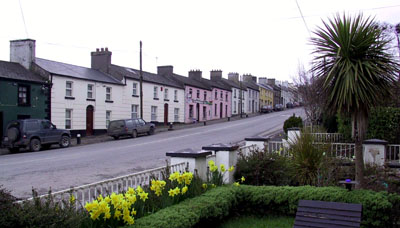
In addition, Kildare County Council has been testing an aquifer in the immediate area and it is believed locally that a flow of 180,000 gallons per hour has been measured in one test well.
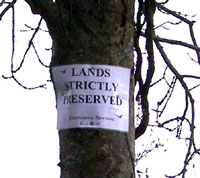 Water which would go a long way to filling a million-gallon reservoir on the Hill of Allen and solve the region’s water supply problems for a long time to come.
Water which would go a long way to filling a million-gallon reservoir on the Hill of Allen and solve the region’s water supply problems for a long time to come.
Still on water, the area under consideration drains into catchments of the rivers Slate, Barrow and Liffey, and also into the Grand Canal.
And finally, the proposed site is part of a preserved wildlife habitat (right), one moreover where Kildare County Council warns of £1,500 fines for littering (below).
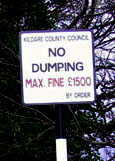 A perfect place to locate a dump to handle the county’s waste for the next 20 years? Local residents aren’t comfortable with that at all.
A perfect place to locate a dump to handle the county’s waste for the next 20 years? Local residents aren’t comfortable with that at all.
OK, residents of anywhere are rarely comfortable with the prospect of a dump in their backyard. And locals here are quite aware that waste disposal is ‘part of our lives’.
“But the science for putting one here is all wrong,” says Jim Dowling (below), a member of the Robertstown Countryside Conservation Group. “It’s in the middle of a 600-acre bog area. There’s a primary school within a mile of the site. And the road infrastructure around here is terrible.”
 Jim Dowling emphasises that the group is not anti-dump per se. But its members do want serious questions answered, and they also want to have the impact of a ‘superdump’ on the community and its environment properly aired.
Jim Dowling emphasises that the group is not anti-dump per se. But its members do want serious questions answered, and they also want to have the impact of a ‘superdump’ on the community and its environment properly aired.
For now, Kildare County Council isn’t taking any part in the debate. Nor is it providing any information to the community. It hasn’t even officially pinpointed the exact site.
“They won’t do any of that until the consultants have finally chosen between the three areas on the shortlist,” says Jim Dowling. “But we’re pretty certain we know where it will be if we’re chosen.”
The final choice is to be made in June. The Robertstown group feel that if they wait until then and its ‘number comes up’, it will be too late to deal with the situation.
“We’ve already had an official council dump in Robertstown, and as far as we’re concerned it was never finished properly,” says Jim Dowling. “Nor is it monitored to see what effect it’s having on the local environment. There were also two other official dumps in the region, as well as a number of unofficial ones.”
There are a number of interesting signs apart from the warning one about litter. Like the one just up the road which leads people along the North Kildare Tourist Route (below). Kildare County Council helped to pay for that one.
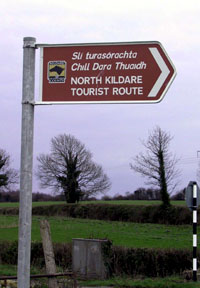 And several signs for Robertstown, a village well known for its efforts over two decades to revive its theme place in history as a typical waypoint on the Grand Canal.
And several signs for Robertstown, a village well known for its efforts over two decades to revive its theme place in history as a typical waypoint on the Grand Canal.
The nearby Hill of Allen, itself famous in mythology but disappearing into trucks of roadstones, overlooks the kind of bogland which is unique in Europe.
“A dump here will impact very strongly on the view from Allen,” notes Jim Dowling, whose group organised an ‘information meeting’ at Newtowndonore last week which attracted over 100 people.
It would impact even more so if it went on fire. Fire which could conceivably run further in bogland in a hot dry summer. Even the controlled flame-offs from the methane eventually generated won’t exactly be a typical part of a landscape which took millions of years to make.
It mightn’t do much for the health of the local wildlife either. Either on the land or in the sky. And any leak of leachate won’t help any in the local waterways.
As far as the people around are concerned, they’re remembering what it took before Kildare County Council finally bought out the homes of a number of people in the area around Silliot Hill.
And Newtowndonore’s population is just like that area. Short on big numbers. Short on votes. Short on the muscle needed to stop it becoming a disposal facility for those large towns which do have the votes and the muscle.
But the area is made up of small communities which are quite unique in their own brand of rurality. Which are very close-knit and caring about each other. And willing to be David against Goliath rather than be overun by dump-trucks without a fight.
And maybe the ‘desktop survey’ hasn’t taken that into account.